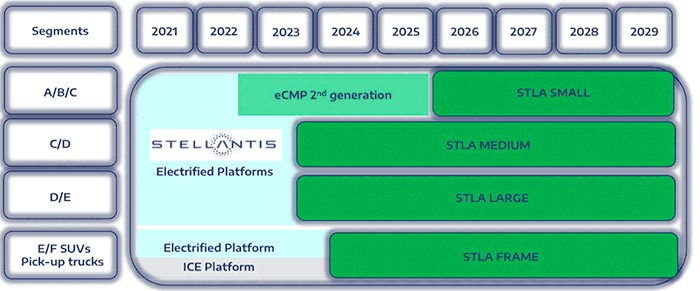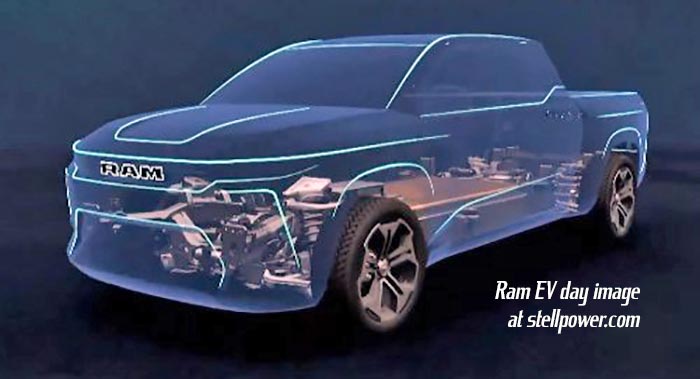Stellantis is planning to end up with just four platforms: Small, Medium, Large, and Frame. But what’s the timing, and where are they coming from?
First, the timing: Carlos Tavares is engaged in a ten year plan, at this point. By 2030, little will remain of the current platforms. For the moment, anything that was in development by either FCA or PSA will likely be released, along with some new vehicles developed quickly to fix huge gaps in product (particularly for Chrysler, Lancia, and Dodge). The rumored Dodge Hornet is one of those—based on an existing car, and not in any way an indication of where the future platforms will be.

First up is STLA Small, which will cover everything from the Fiat 500 up to the smaller compact cars and crossovers. This is based on Peugeot’s EMP1/CMP platform, but will likely have any useful innovations from FCA’s small car platform (Compass, Renegade) as well. This platform aimed at B-sized (subcompact) cars, mainly, as well as smaller compact (C) car; the first car on the platform was the 2018 DS3. The wheelbase is around 100 inches. Globally, they have a variety of engines from one-liter turbo three-cylinders on up. This is the platform that will likely replace the Jeep Renegade and maybe the Compass, assuming those vehicles are retained. It’s also possible Jeep will exit the low end eventually, when the FCA platforms are exhausted, and live in the big, expensive realms, starting with an STLA Large Cherokee and going up from there.
This platform, new as it is, will not continue as such; a second generation will form the basis of new cars into 2025 before STLA Small starts in around 2026. The electrified version of EMP2 is eCMP 2, due to arrive next year (2023 model year). It is likely that STLA Small will, therefore, be based on eCMP—again, with any designs that FCA has done better integrated into it. This would be like the new GSE and GME engines, which contain elements of both Fiat and Chrysler engines, and were developed by a former-Chrysler leader working under a former-Fiat leader.
Vehicles in this class are disadvantaged by USA fuel economy regulations; those punish cars with a wheelbase under 120 inches and smaller MPVs. However, this platform is ideal for Latin America, due to the regulations there, as well as Europe.
Next is STLA Medium, the EMP2 platform, whose electrified version is dubbed eVMP (but is the fourth generation of EMP). The third-generation EMP2 platform was engineered to work in the United States as well, and may replace the Cherokee, eventually; it would also provide a replacement for the Journey and possibly be stretched into minivan duty unless STLA Large is flexible enough for that.
STLA Medium is the equivalent of today’s CUSW and C-EVO platforms at FCA; they are likely to have little influence on STLA Medium, given their age and the weight of the vehicles on CUSW. Indeed, it was notable that the new Jeep Compass was based on the small-car platform, not CUSW, even though the CUSW-based Cherokee was able to pass the Rubicon Trail test and the small-platform Renegade was not.
STLA Medium may be key to Chrysler and Dodge, as that is the heart of the American market—the place where the best sellers (RAV4, Corolla, Camry, CRV, Civic, Camry) live.

STLA Large is likely based on an evolution of Giorgio, but so evolved that it’s hard to find the original in there. Giorgio is allegedly consigned entirely to Alfa Romeo only, while whatever STLA Large is coming from—in 2023—will likely be used in a wide variety of vehicles, including any continuation of the Charger and Challenger, not to mention the Grand Cherokee.
Little is known about STLA Large right now, and there is even a great deal of debate over whether the Grand Cherokee is based on Giorgio, since Jim Morrison, the leader of Jeep, called it a clean-sheet design. So far there have been no large Giorgio-based cars, if Grand Cherokee is indeed unique.
Also unknown is whether STLA Large will have a fixed set of drive wheels, e.g. RWD; if not, it could be used for minivans, large crossovers, and large sedans and coupes. Front wheel drive provides definite market advantages in some segments, and no rear wheel drive minivan has been a market success. It’s possible BEV versions of these vehicles will make that academic, or that there are plans to simply move everything to AWD.

STLA Frame is likely to be a flexibly defined platform/architecture, since it will need to handle different frames (Ram 1500, 2500, 3500 at least) and most likely different suspensions (Ram 2500 has link/coil and Ram 3500 has leaf springs). This will almost certainly be based on current Ram engineering, but might be altered to allow for easier sharing with, say, a smaller Jeep Cherokee or other high-end vehicles based on the Ram 1500.
STLA Frame is still years away, as are all of these; and new cars based on older platforms and architectures are being brought to market even as the new platforms are launched, so there is likely to be a riotous confusion of vehicles with various origins until the four-platform plan is put into effect. What’s more, these plans will all seem familiar to those who remember Sergio Marchionne’s five year plans from 2009-2012; and he found it was impossible to move everything into such neat boxes without losing the reasons why people bought those vehicles in the first place. Much will ride on how, technically, Stellantis defines “platforms” and how much flexibility is built into them.
Discover more from Stellpower - that Mopar news site
Subscribe to get the latest posts sent to your email.

